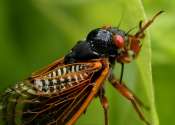Evolution in reverse: insects recover lost 'wings'
The extravagant headgear of small bugs called treehoppers are in fact wing-like appendages that grew back 200 million years after evolution had supposedly cast them aside, according to a study published Thursday in Nature.








